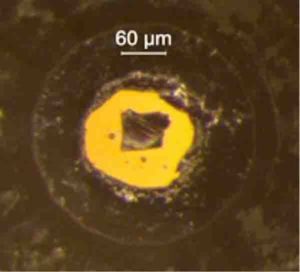
Nearly 1,800 miles below the earth’s surface, there are large odd structures lurking at the base of the mantle, sitting just above the core. The mantle is a thick layer of hot, mostly plastic rock that surrounds the core; atop the mantle is the thin shell of the earth’s crust. On geologic time scales, the mantle behaves like a viscous liquid, with solid elements sinking and rising through its depths.
The aforementioned odd structures, known as ultra-low velocity zones (ULVZs), were first discovered in 1995 by Caltech’s Don Helmberger. ULVZs can be studied by measuring how they alter the seismic waves that pass through them. But observing is not necessarily understanding. Indeed, no one is really sure what these structures are.
ULVZs are so-named because they significantly slow down the speeds of seismic waves; for example, they slow down shear waves (oscillating seismic waves capable of moving through solid bodies) by as much as 30 percent. ULVZs are several miles thick and can be hundreds of miles across. Several are scattered near the earth’s core roughly beneath the Pacific Rim. Others are clustered underneath North America, Europe, and Africa.
“ULVZs exist so deep in the inner earth that they are impossible to study directly, which poses a significant challenge when trying to determine what exactly they are,” says Helmberger, Smits Family Professor of Geophysics, Emeritus.
Earth scientists at Caltech now say they know not just what ULVZs are made of, but where they come from. Using experimental methods at high pressures, the researchers, led by Professor of Mineral Physics Jennifer Jackson, have found that ULVZs consist of chunks of a magnesium/iron oxide mineral called magnesiowüstite that could have precipitated out of a magma ocean that is thought to have existed at the base of the mantle millions of years ago.
The other leading theory for ULVZs formation had suggested that they consist of melted material, some of it possibly leaking up from the core.
Jackson and her colleagues, who reported on their work in a recent paper in the Journal of Geophysical Research: Solid Earth, found evidence supporting the magnesiowüstite theory by studying the mineral’s elastic (or seismic) anisotropy; elastic anisotropy is a variation in the speed at which seismic waves pass through a mineral depending on their direction of travel.
One particularly unusual characteristic of the region where ULVZs exist—the core-mantle boundary (CMB)—is that it is highly heterogenous (nonuniform in character) as well as anisotropic. As a result, the speed at which seismic waves travel through the CMB varies based not only on the region that the waves are passing through but on the direction in which those waves are moving. The propagation direction, in fact, can alter the speed of the waves by a factor of three.
“Previously, scientists explained the anisotropy as the result of seismic waves passing through a dense silicate material. What we’re suggesting is that in some regions, it is largely due to the alignment of magnesiowüstite within ULVZs,” says Jackson.
At the pressures and temperatures experienced at the earth’s surface, magnesiowüstite exhibits little anisotropy. However, Jackson and her team found that the mineral becomes strongly anisotropic when subjected to pressures comparable to those found in the lower mantle.
Jackson and her colleagues discovered this by placing a single crystal of magnesiowüstite in a diamond anvil cell, which is essentially a tiny chamber located between two diamonds. When the rigid diamonds are compressed against one another, the pressure inside the chamber rises. Jackson and her colleagues then bombarded the sample with x-rays. The interaction of the x-rays with the sample acts as a proxy for how seismic waves will travel through the material. At a pressure of 40 gigapascals—equivalent to the pressure at the lower mantle—magnesiowüstite was significantly more anisotropic than seismic observations of ULVZs.
In order to create objects as large and strongly anisotropic as ULVZs, only a small amount of magnesiowüstite crystals need to be aligned in one specific direction, probably due to the application of pressure from a strong outside force. This could be explained by a subducting slab of the earth’s crust pushing its way to the CMB, Jackson says. (Subduction occurs at certain boundaries between earth’s tectonic plates, where one plate dives below another, triggering volcanism and earthquakes.)
“Scientists are still in the process of discovering what happens to the crust when it’s subducted into the mantle,” Jackson says. “One possibility, which our research now seems to support, is that these slabs push all the way down to the core-mantle boundary and help to shape ULVZs.”
Next, Jackson plans to explore the interaction of subducting slabs, ULVZs, and their seismic signatures. Interpreting these features will help place constraints on processes that happened early in Earth’s history, she says.
The study is titled “Strongly Anisotropic Magnesiowüstite in Earth’s Lower Mantle.”
Reference:
Gregory J. Finkelstein et al. Strongly Anisotropic Magnesiowüstite in Earth’s Lower Mantle, Journal of Geophysical Research: Solid Earth (2018). DOI: 10.1029/2017JB015349
Note: The above post is reprinted from materials provided by California Institute of Technology.










